FNSrsk602 - Risk Implementation Plan: Westpac Bank Group Analysis
VerifiedAdded on 2023/04/20
|9
|1342
|320
Report
AI Summary
This report outlines a risk implementation plan for the Westpac Bank Group, focusing on the management of the implementation strategy, monitoring and evaluation methods, and project management requirements. It details the roles of the project manager and other stakeholders in ensuring the successful development and deployment of software applications. The plan includes a work breakdown structure (WBS), assessment of project risks, resource management strategies, performance management and tracking, project financial management, and resource acquisition processes. It also covers budgeting, project scheduling, continual improvement management, and identification of necessary resources. The report emphasizes the importance of monitoring and evaluating the implementation strategy to ensure adherence to best practices in project management. Desklib offers a variety of past papers and solved assignments for students to aid in their studies.

Risk Implementation Plan 1
RISK IMPLEMENTATION PLAN
Module Name
Module Code
Institution Affiliation
Word Count: 951
Risk Implementation Plan
Management of the Implementation Strategy
The management of the risk implementation strategy is centered on the project manager at the Westpac Bank Group. Complex company like the financial
institution need a well-defined organizational structure to enhance the management of its risk. The managing of the implementation strategy focusses on the assuring
the desired software application is developed, data is presented to the targeted users and methodology documentation is presented, following an established financial
management scheme. The company works progressively with all the relevant stakeholders to ensure the desired aims and objectives are attained.
Student Name, Unit Code, April 12, 2019
RISK IMPLEMENTATION PLAN
Module Name
Module Code
Institution Affiliation
Word Count: 951
Risk Implementation Plan
Management of the Implementation Strategy
The management of the risk implementation strategy is centered on the project manager at the Westpac Bank Group. Complex company like the financial
institution need a well-defined organizational structure to enhance the management of its risk. The managing of the implementation strategy focusses on the assuring
the desired software application is developed, data is presented to the targeted users and methodology documentation is presented, following an established financial
management scheme. The company works progressively with all the relevant stakeholders to ensure the desired aims and objectives are attained.
Student Name, Unit Code, April 12, 2019
Paraphrase This Document
Need a fresh take? Get an instant paraphrase of this document with our AI Paraphraser
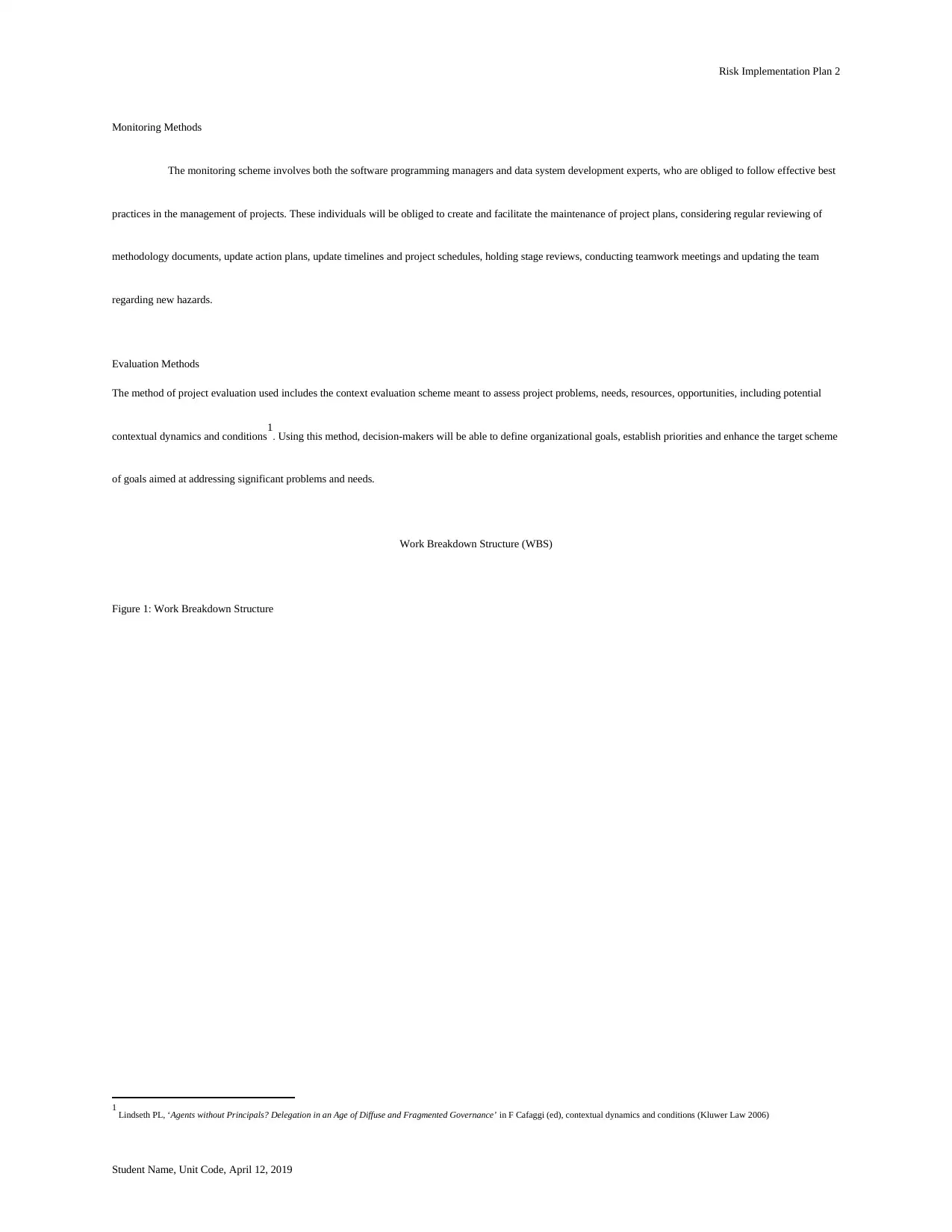
Risk Implementation Plan 2
Monitoring Methods
The monitoring scheme involves both the software programming managers and data system development experts, who are obliged to follow effective best
practices in the management of projects. These individuals will be obliged to create and facilitate the maintenance of project plans, considering regular reviewing of
methodology documents, update action plans, update timelines and project schedules, holding stage reviews, conducting teamwork meetings and updating the team
regarding new hazards.
Evaluation Methods
The method of project evaluation used includes the context evaluation scheme meant to assess project problems, needs, resources, opportunities, including potential
contextual dynamics and conditions1. Using this method, decision-makers will be able to define organizational goals, establish priorities and enhance the target scheme
of goals aimed at addressing significant problems and needs.
Work Breakdown Structure (WBS)
Figure 1: Work Breakdown Structure
1 Lindseth PL, ‘Agents without Principals? Delegation in an Age of Diffuse and Fragmented Governance’ in F Cafaggi (ed), contextual dynamics and conditions (Kluwer Law 2006)
Student Name, Unit Code, April 12, 2019
Monitoring Methods
The monitoring scheme involves both the software programming managers and data system development experts, who are obliged to follow effective best
practices in the management of projects. These individuals will be obliged to create and facilitate the maintenance of project plans, considering regular reviewing of
methodology documents, update action plans, update timelines and project schedules, holding stage reviews, conducting teamwork meetings and updating the team
regarding new hazards.
Evaluation Methods
The method of project evaluation used includes the context evaluation scheme meant to assess project problems, needs, resources, opportunities, including potential
contextual dynamics and conditions1. Using this method, decision-makers will be able to define organizational goals, establish priorities and enhance the target scheme
of goals aimed at addressing significant problems and needs.
Work Breakdown Structure (WBS)
Figure 1: Work Breakdown Structure
1 Lindseth PL, ‘Agents without Principals? Delegation in an Age of Diffuse and Fragmented Governance’ in F Cafaggi (ed), contextual dynamics and conditions (Kluwer Law 2006)
Student Name, Unit Code, April 12, 2019
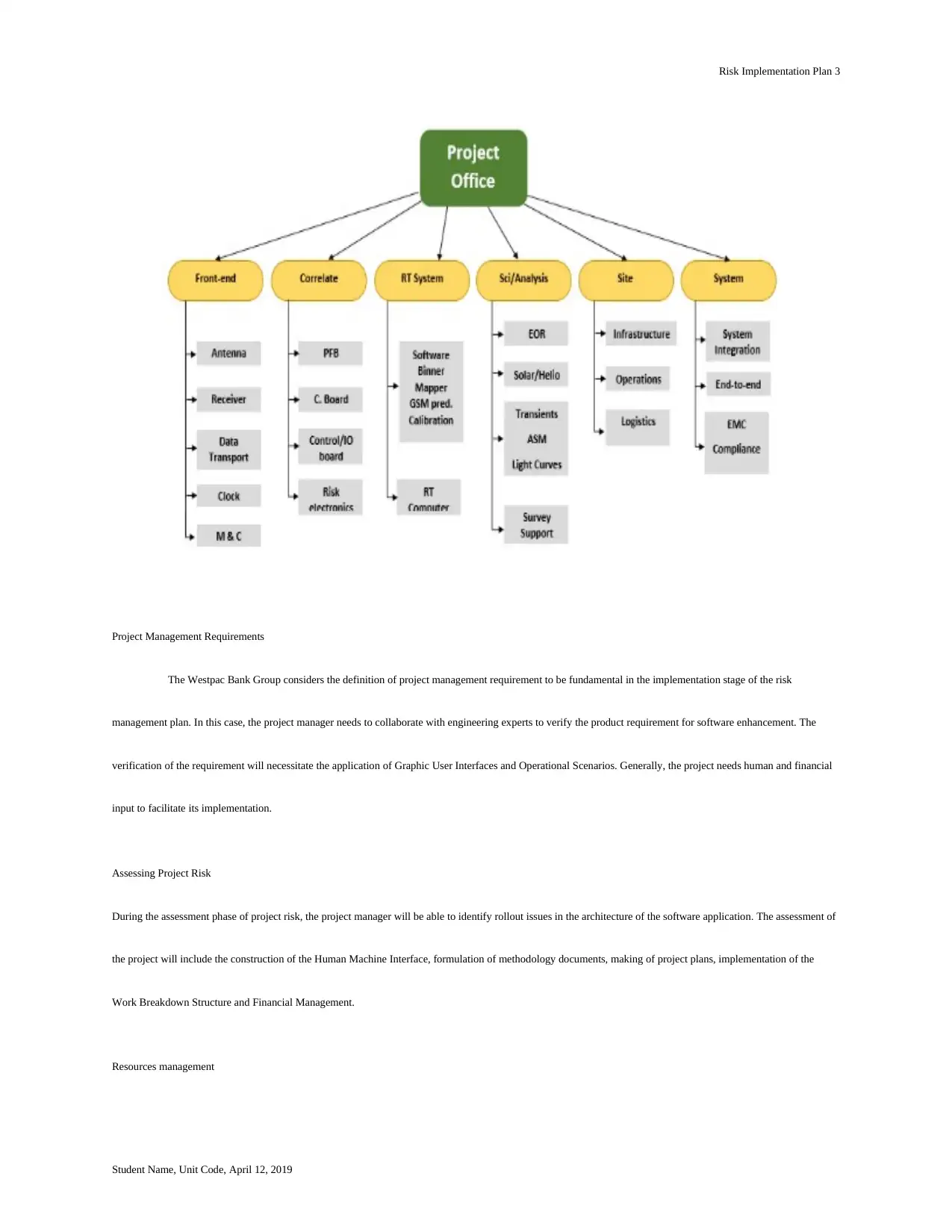
Risk Implementation Plan 3
Project Management Requirements
The Westpac Bank Group considers the definition of project management requirement to be fundamental in the implementation stage of the risk
management plan. In this case, the project manager needs to collaborate with engineering experts to verify the product requirement for software enhancement. The
verification of the requirement will necessitate the application of Graphic User Interfaces and Operational Scenarios. Generally, the project needs human and financial
input to facilitate its implementation.
Assessing Project Risk
During the assessment phase of project risk, the project manager will be able to identify rollout issues in the architecture of the software application. The assessment of
the project will include the construction of the Human Machine Interface, formulation of methodology documents, making of project plans, implementation of the
Work Breakdown Structure and Financial Management.
Resources management
Student Name, Unit Code, April 12, 2019
Project Management Requirements
The Westpac Bank Group considers the definition of project management requirement to be fundamental in the implementation stage of the risk
management plan. In this case, the project manager needs to collaborate with engineering experts to verify the product requirement for software enhancement. The
verification of the requirement will necessitate the application of Graphic User Interfaces and Operational Scenarios. Generally, the project needs human and financial
input to facilitate its implementation.
Assessing Project Risk
During the assessment phase of project risk, the project manager will be able to identify rollout issues in the architecture of the software application. The assessment of
the project will include the construction of the Human Machine Interface, formulation of methodology documents, making of project plans, implementation of the
Work Breakdown Structure and Financial Management.
Resources management
Student Name, Unit Code, April 12, 2019
⊘ This is a preview!⊘
Do you want full access?
Subscribe today to unlock all pages.

Trusted by 1+ million students worldwide
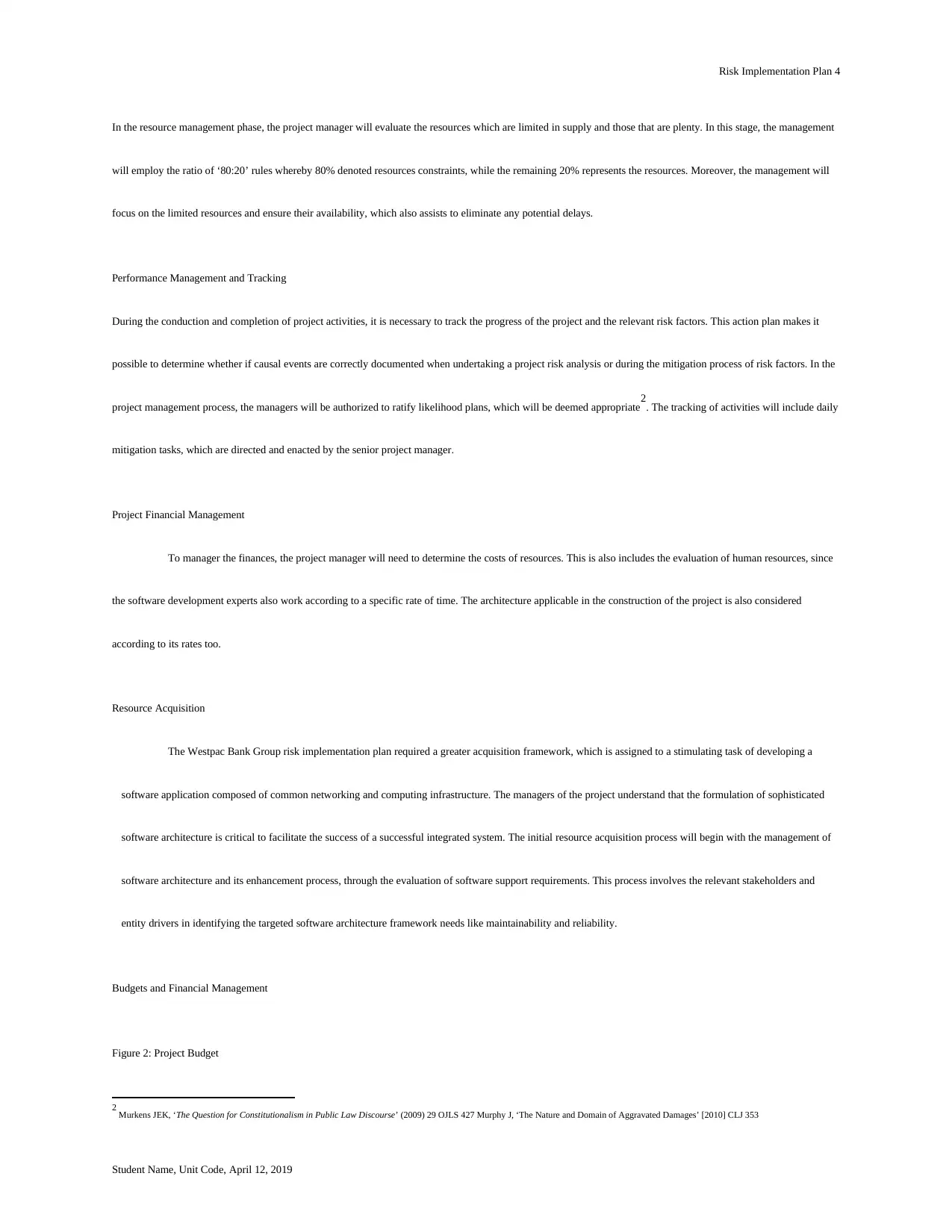
Risk Implementation Plan 4
In the resource management phase, the project manager will evaluate the resources which are limited in supply and those that are plenty. In this stage, the management
will employ the ratio of ‘80:20’ rules whereby 80% denoted resources constraints, while the remaining 20% represents the resources. Moreover, the management will
focus on the limited resources and ensure their availability, which also assists to eliminate any potential delays.
Performance Management and Tracking
During the conduction and completion of project activities, it is necessary to track the progress of the project and the relevant risk factors. This action plan makes it
possible to determine whether if causal events are correctly documented when undertaking a project risk analysis or during the mitigation process of risk factors. In the
project management process, the managers will be authorized to ratify likelihood plans, which will be deemed appropriate2. The tracking of activities will include daily
mitigation tasks, which are directed and enacted by the senior project manager.
Project Financial Management
To manager the finances, the project manager will need to determine the costs of resources. This is also includes the evaluation of human resources, since
the software development experts also work according to a specific rate of time. The architecture applicable in the construction of the project is also considered
according to its rates too.
Resource Acquisition
The Westpac Bank Group risk implementation plan required a greater acquisition framework, which is assigned to a stimulating task of developing a
software application composed of common networking and computing infrastructure. The managers of the project understand that the formulation of sophisticated
software architecture is critical to facilitate the success of a successful integrated system. The initial resource acquisition process will begin with the management of
software architecture and its enhancement process, through the evaluation of software support requirements. This process involves the relevant stakeholders and
entity drivers in identifying the targeted software architecture framework needs like maintainability and reliability.
Budgets and Financial Management
Figure 2: Project Budget
2 Murkens JEK, ‘The Question for Constitutionalism in Public Law Discourse’ (2009) 29 OJLS 427 Murphy J, ‘The Nature and Domain of Aggravated Damages’ [2010] CLJ 353
Student Name, Unit Code, April 12, 2019
In the resource management phase, the project manager will evaluate the resources which are limited in supply and those that are plenty. In this stage, the management
will employ the ratio of ‘80:20’ rules whereby 80% denoted resources constraints, while the remaining 20% represents the resources. Moreover, the management will
focus on the limited resources and ensure their availability, which also assists to eliminate any potential delays.
Performance Management and Tracking
During the conduction and completion of project activities, it is necessary to track the progress of the project and the relevant risk factors. This action plan makes it
possible to determine whether if causal events are correctly documented when undertaking a project risk analysis or during the mitigation process of risk factors. In the
project management process, the managers will be authorized to ratify likelihood plans, which will be deemed appropriate2. The tracking of activities will include daily
mitigation tasks, which are directed and enacted by the senior project manager.
Project Financial Management
To manager the finances, the project manager will need to determine the costs of resources. This is also includes the evaluation of human resources, since
the software development experts also work according to a specific rate of time. The architecture applicable in the construction of the project is also considered
according to its rates too.
Resource Acquisition
The Westpac Bank Group risk implementation plan required a greater acquisition framework, which is assigned to a stimulating task of developing a
software application composed of common networking and computing infrastructure. The managers of the project understand that the formulation of sophisticated
software architecture is critical to facilitate the success of a successful integrated system. The initial resource acquisition process will begin with the management of
software architecture and its enhancement process, through the evaluation of software support requirements. This process involves the relevant stakeholders and
entity drivers in identifying the targeted software architecture framework needs like maintainability and reliability.
Budgets and Financial Management
Figure 2: Project Budget
2 Murkens JEK, ‘The Question for Constitutionalism in Public Law Discourse’ (2009) 29 OJLS 427 Murphy J, ‘The Nature and Domain of Aggravated Damages’ [2010] CLJ 353
Student Name, Unit Code, April 12, 2019
Paraphrase This Document
Need a fresh take? Get an instant paraphrase of this document with our AI Paraphraser
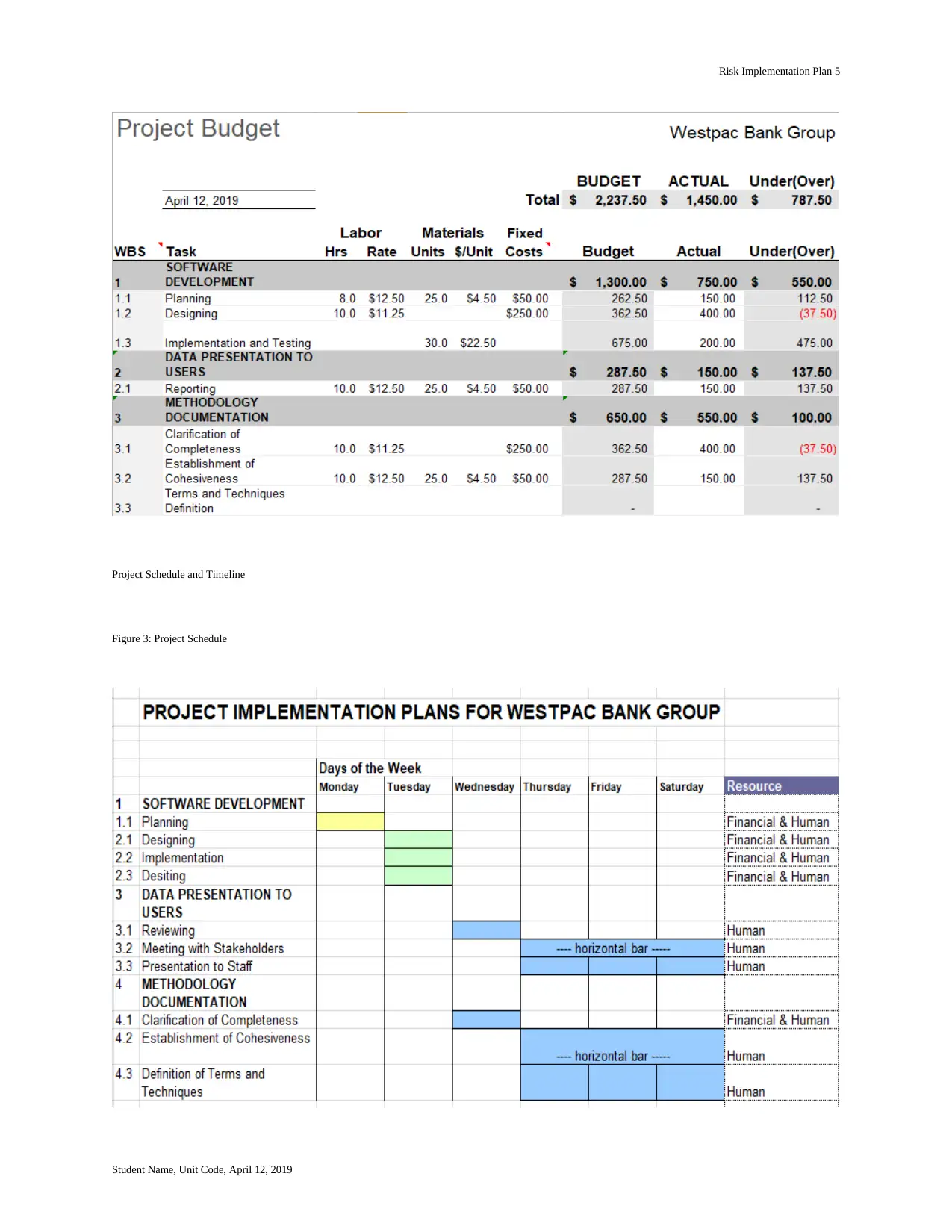
Risk Implementation Plan 5
Project Schedule and Timeline
Figure 3: Project Schedule
Student Name, Unit Code, April 12, 2019
Project Schedule and Timeline
Figure 3: Project Schedule
Student Name, Unit Code, April 12, 2019
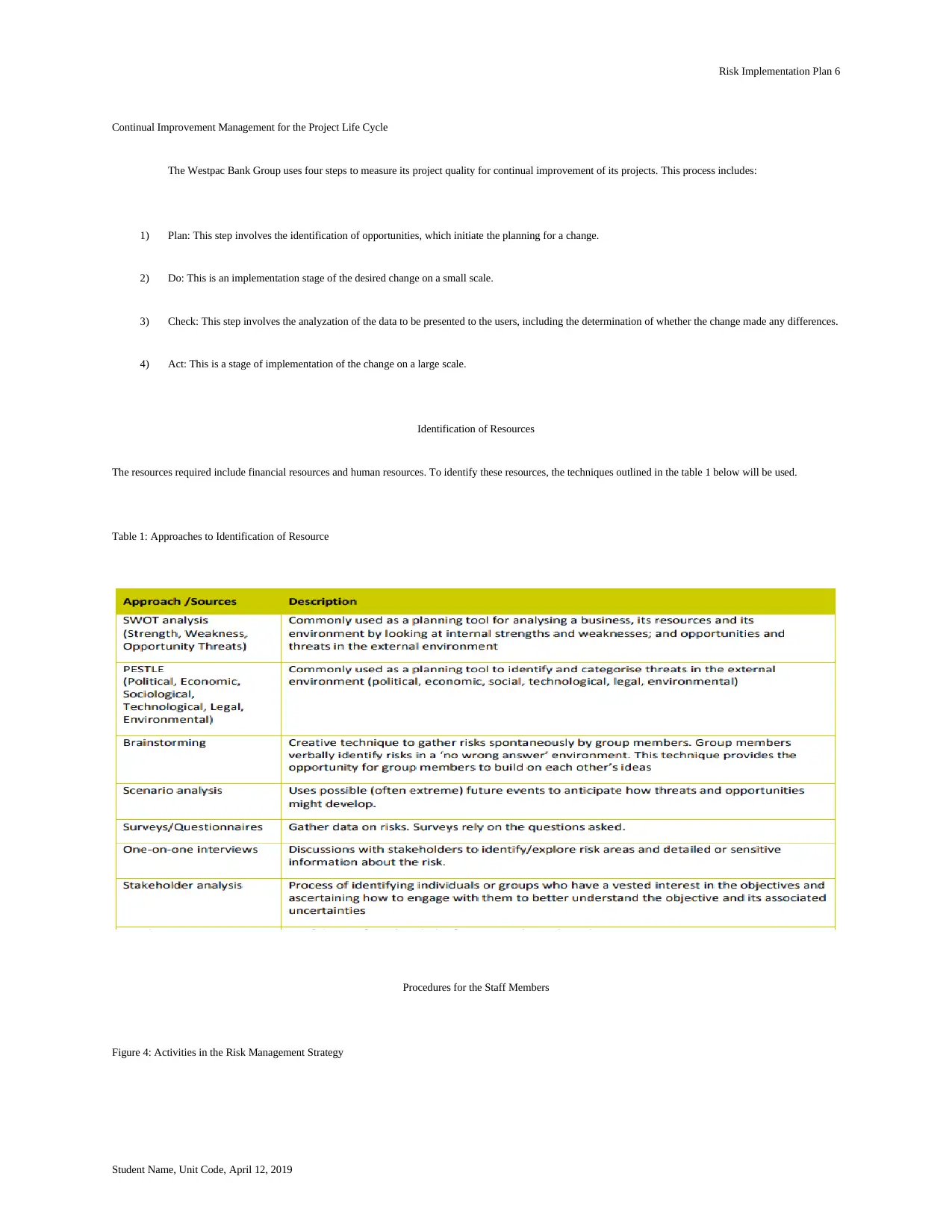
Risk Implementation Plan 6
Continual Improvement Management for the Project Life Cycle
The Westpac Bank Group uses four steps to measure its project quality for continual improvement of its projects. This process includes:
1) Plan: This step involves the identification of opportunities, which initiate the planning for a change.
2) Do: This is an implementation stage of the desired change on a small scale.
3) Check: This step involves the analyzation of the data to be presented to the users, including the determination of whether the change made any differences.
4) Act: This is a stage of implementation of the change on a large scale.
Identification of Resources
The resources required include financial resources and human resources. To identify these resources, the techniques outlined in the table 1 below will be used.
Table 1: Approaches to Identification of Resource
Procedures for the Staff Members
Figure 4: Activities in the Risk Management Strategy
Student Name, Unit Code, April 12, 2019
Continual Improvement Management for the Project Life Cycle
The Westpac Bank Group uses four steps to measure its project quality for continual improvement of its projects. This process includes:
1) Plan: This step involves the identification of opportunities, which initiate the planning for a change.
2) Do: This is an implementation stage of the desired change on a small scale.
3) Check: This step involves the analyzation of the data to be presented to the users, including the determination of whether the change made any differences.
4) Act: This is a stage of implementation of the change on a large scale.
Identification of Resources
The resources required include financial resources and human resources. To identify these resources, the techniques outlined in the table 1 below will be used.
Table 1: Approaches to Identification of Resource
Procedures for the Staff Members
Figure 4: Activities in the Risk Management Strategy
Student Name, Unit Code, April 12, 2019
⊘ This is a preview!⊘
Do you want full access?
Subscribe today to unlock all pages.

Trusted by 1+ million students worldwide
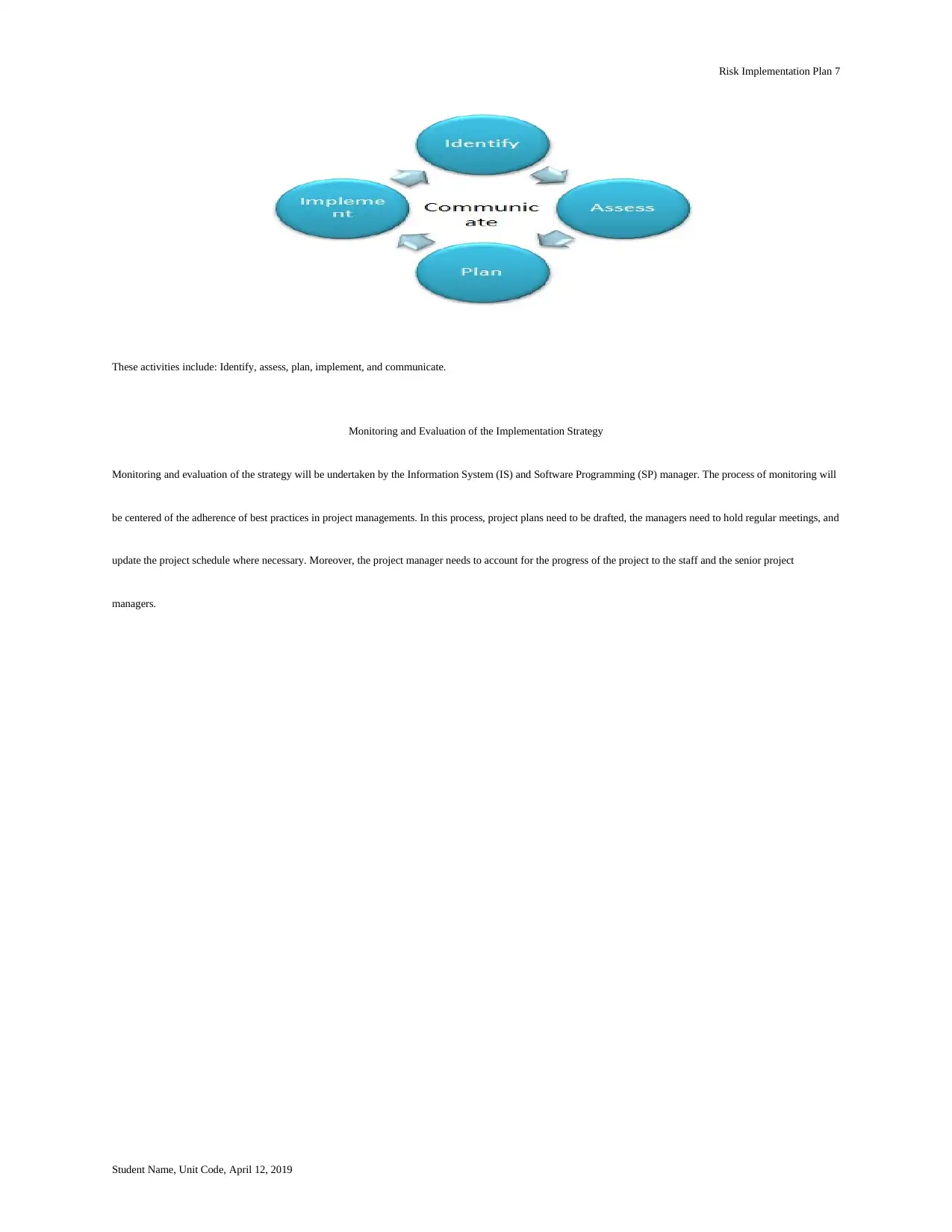
Risk Implementation Plan 7
These activities include: Identify, assess, plan, implement, and communicate.
Monitoring and Evaluation of the Implementation Strategy
Monitoring and evaluation of the strategy will be undertaken by the Information System (IS) and Software Programming (SP) manager. The process of monitoring will
be centered of the adherence of best practices in project managements. In this process, project plans need to be drafted, the managers need to hold regular meetings, and
update the project schedule where necessary. Moreover, the project manager needs to account for the progress of the project to the staff and the senior project
managers.
Student Name, Unit Code, April 12, 2019
These activities include: Identify, assess, plan, implement, and communicate.
Monitoring and Evaluation of the Implementation Strategy
Monitoring and evaluation of the strategy will be undertaken by the Information System (IS) and Software Programming (SP) manager. The process of monitoring will
be centered of the adherence of best practices in project managements. In this process, project plans need to be drafted, the managers need to hold regular meetings, and
update the project schedule where necessary. Moreover, the project manager needs to account for the progress of the project to the staff and the senior project
managers.
Student Name, Unit Code, April 12, 2019
Paraphrase This Document
Need a fresh take? Get an instant paraphrase of this document with our AI Paraphraser
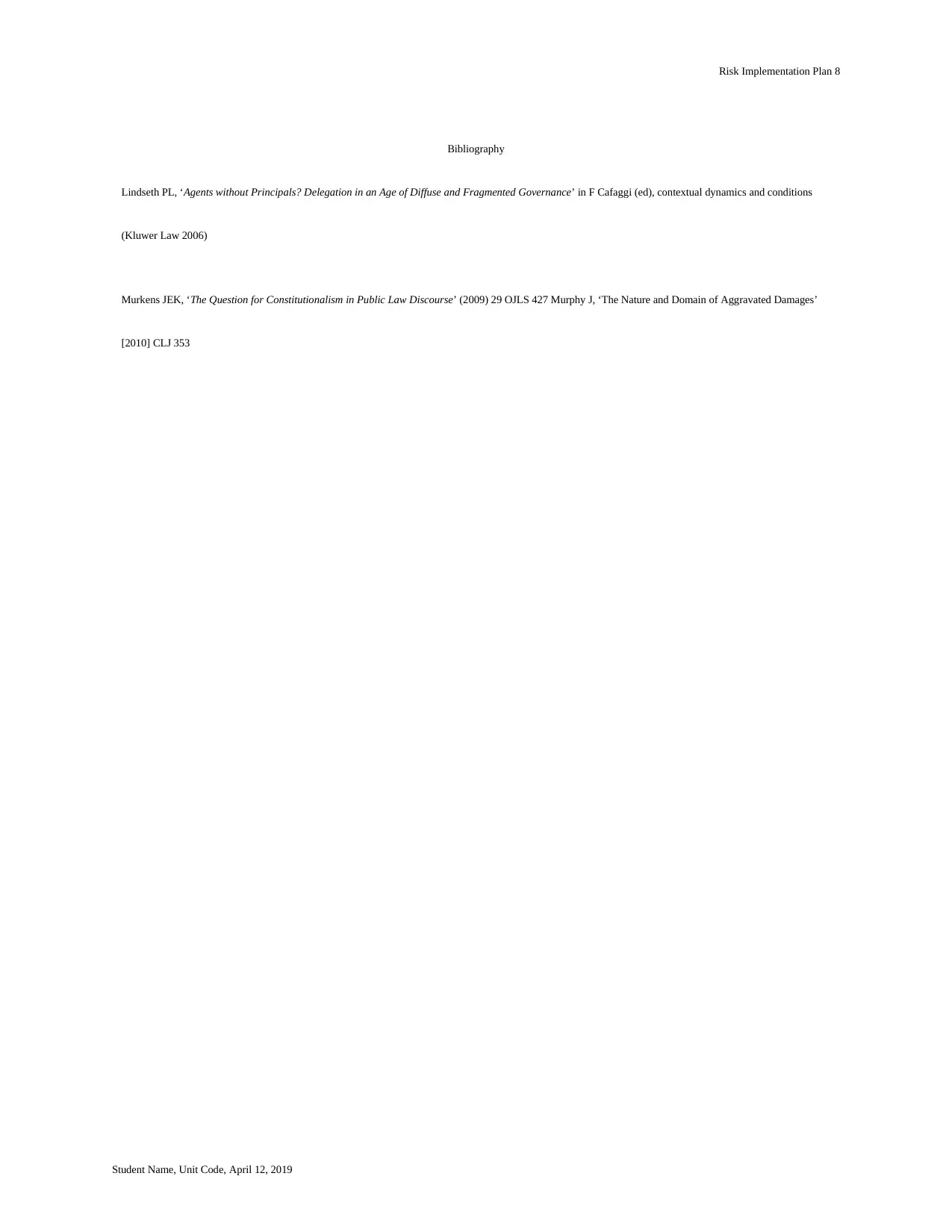
Risk Implementation Plan 8
Bibliography
Lindseth PL, ‘Agents without Principals? Delegation in an Age of Diffuse and Fragmented Governance’ in F Cafaggi (ed), contextual dynamics and conditions
(Kluwer Law 2006)
Murkens JEK, ‘The Question for Constitutionalism in Public Law Discourse’ (2009) 29 OJLS 427 Murphy J, ‘The Nature and Domain of Aggravated Damages’
[2010] CLJ 353
Student Name, Unit Code, April 12, 2019
Bibliography
Lindseth PL, ‘Agents without Principals? Delegation in an Age of Diffuse and Fragmented Governance’ in F Cafaggi (ed), contextual dynamics and conditions
(Kluwer Law 2006)
Murkens JEK, ‘The Question for Constitutionalism in Public Law Discourse’ (2009) 29 OJLS 427 Murphy J, ‘The Nature and Domain of Aggravated Damages’
[2010] CLJ 353
Student Name, Unit Code, April 12, 2019
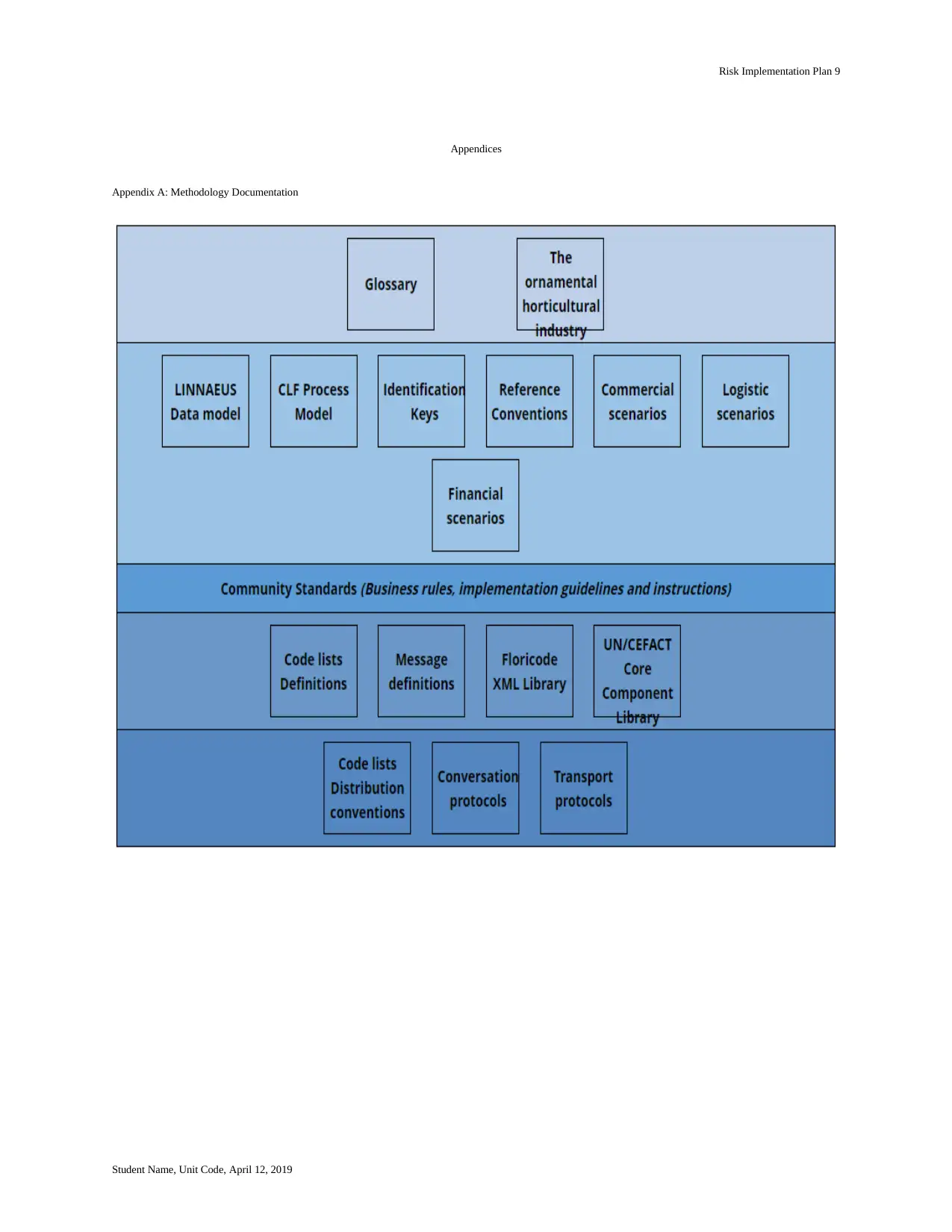
Risk Implementation Plan 9
Appendices
Appendix A: Methodology Documentation
Student Name, Unit Code, April 12, 2019
Appendices
Appendix A: Methodology Documentation
Student Name, Unit Code, April 12, 2019
⊘ This is a preview!⊘
Do you want full access?
Subscribe today to unlock all pages.

Trusted by 1+ million students worldwide
1 out of 9
Related Documents
Your All-in-One AI-Powered Toolkit for Academic Success.
+13062052269
info@desklib.com
Available 24*7 on WhatsApp / Email
![[object Object]](/_next/static/media/star-bottom.7253800d.svg)
Unlock your academic potential
Copyright © 2020–2025 A2Z Services. All Rights Reserved. Developed and managed by ZUCOL.




